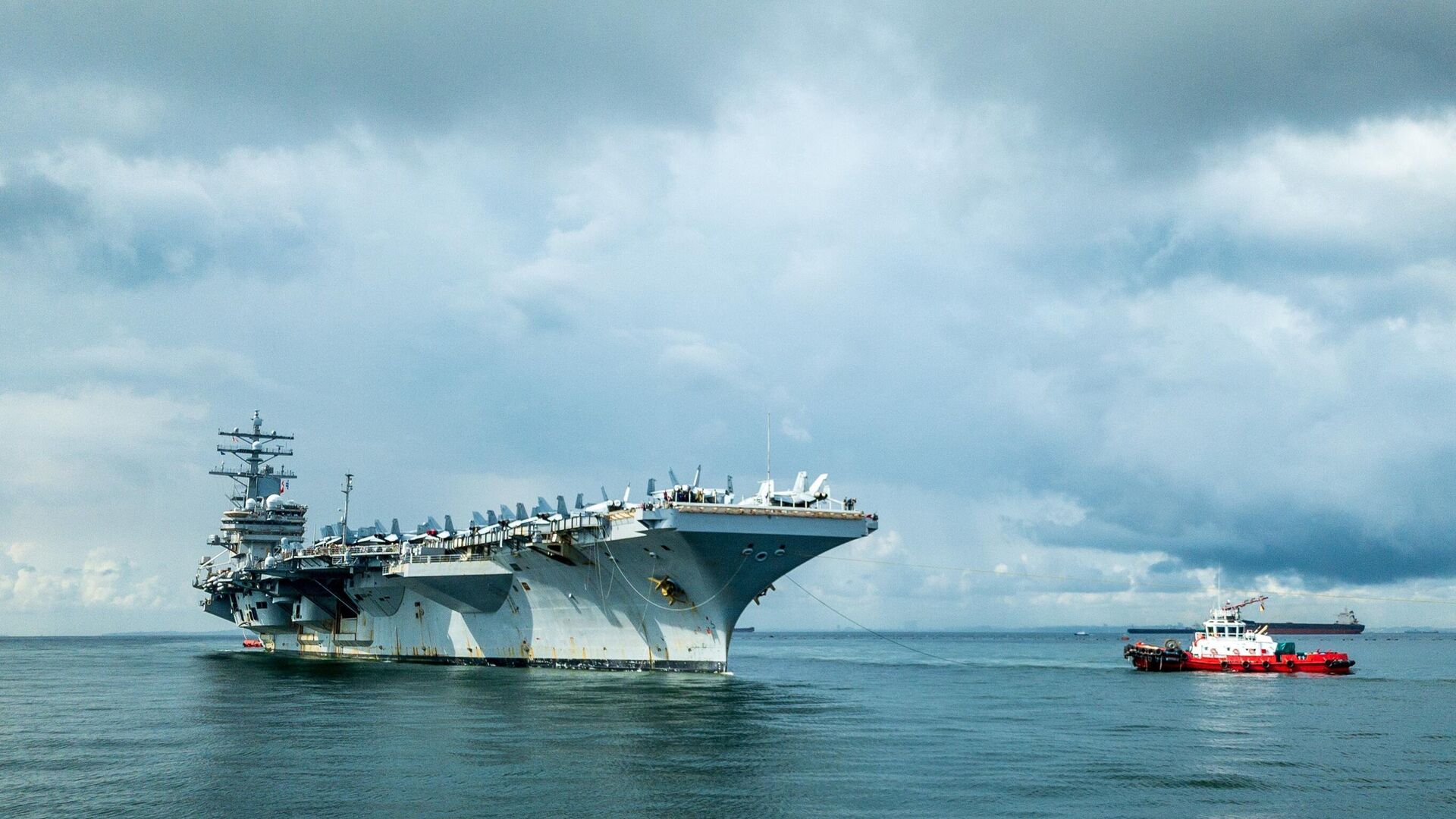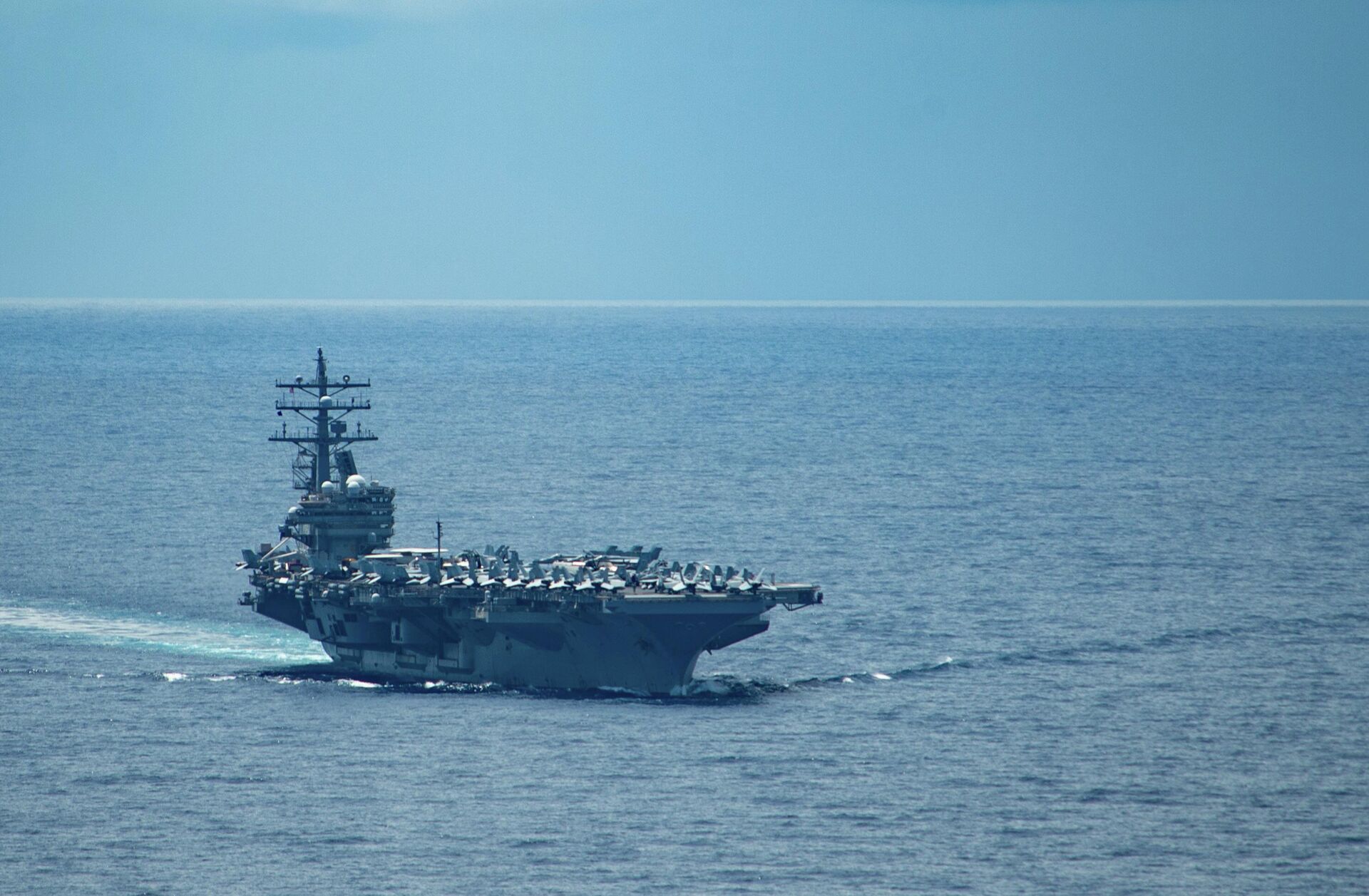https://sputnikglobe.com/20220727/us-carrier-battle-group-steams-toward-taiwan-as-pelosi-invites-more-lawmakers-on-island-visit-1097864634.html
US Carrier Battle Group Steams Toward Taiwan as Pelosi Invites More Lawmakers on Island Visit
US Carrier Battle Group Steams Toward Taiwan as Pelosi Invites More Lawmakers on Island Visit
Sputnik International
A US aircraft carrier and its retinue of warships departed from Singapore on Tuesday, steaming northward toward Taiwan. US House Speaker Nancy Pelosi (D-CA) is... 27.07.2022, Sputnik International
2022-07-27T18:41+0000
2022-07-27T18:41+0000
2023-06-19T12:44+0000
us
china
south china sea
taiwan
https://cdn1.img.sputnikglobe.com/img/07e6/07/1b/1097864824_0:256:2730:1792_1920x0_80_0_0_2a32bf3aa36b583c8153ab5f99bf2ab3.jpg
The Nimitz-class aircraft carrier USS Ronald Reagan and one of its escorts, the Ticonderoga-class guided-missile cruiser USS Antietam, left Singapore’s Changi Naval Base on Tuesday following a four-day stay in the city-state, the Seventh US Fleet announced. The visit came at the end of a tour of the region that included the biennial Valiant Shield exercise in the Philippine Sea and the South China Sea and a stop in the Vietnamese port city of Danang.A news release did not say the full size of the battle group, but noted it included Reagan and Antietam as well as another “Tico” cruiser - the USS Chancellorsville - and “ships, crew and staff” from Carrier Strike Group 5 and Destroyer Squadron 15, which includes eight Arleigh Burke-class destroyers. Including the USS Reagan’s 10 aircraft squadrons, the flotilla is clearly a formidable task force.It also did not state the battle group’s destination, but satellite data from the South China Sea Probing Initiative (SCSPI), a Beijing-based think tank that monitors activity in the waterway, spotted Antietam and Reagan near Malaysia’s Riau archipelago in the South China Sea later on Tuesday.Notably, the think tank highlighted no other US warships in the area, possibly signaling that Reagan left most of her task force behind for the port calls.Reagan is the US’ only forward-deployed carrier, based in Yokosuka, Japan, instead of at a naval base in the United States.Pelosi Invites More on Provocative Taiwan TripThe tour comes amid renewed plans by Pelosi, the third-most powerful US politician after US President Joe Biden and Vice President Kamala Harris, to visit Taiwan. Her plans for an April trip were canceled after she contracted COVID-19, but she recently announced her intent to go once more, and reports say the trip could come in early August.The People’s Republic of China (PRC), which regards Taiwan as a Chinese province in rebellion and sees US support for the government in Taiwan as a violation of Chinese sovereignty and interference in Chinese internal affairs, has strongly protested the planned trip. It would be the highest-profile visit by a US politician since 1997 and would come after a series of visits in the last year by other high-ranking US politicians and figures, including former Secretary of State and former CIA director Mike Pompeo and former Pentagon chief Mark Esper.Pelosi’s fellow Democrats, including Biden, and senior Pentagon leaders have all tried to dissuade her from the provocative trip, which many leading Republicans - typically adversarial to Pelosi’s politics - have rallied behind.Now, the senior Democratic lawmaker is trying to bring more of her colleagues with her.Pelosi on Wednesday reportedly extended invitations to Rep. Gregory Meeks (D-NY), the chair of the House Foreign Affairs Committee, and to Rep. Michael McCaul (R-TX), the committee’s ranking member. However, McCaul has already passed on the offer, although he expressed his support for the visit.Zhao Lijian, a spokesperson for the Chinese Foreign Ministry, warned on Wednesday that Pelosi’s visit “challenges China’s red line, it will be met with resolute countermeasures.”“The US must assume full responsibility for any serious consequence arising thereof,” Zhao added.Many have speculated whether China would try to close the airspace over or around Taiwan - and questioned whether it could. Taipei is extremely defensive about PRC incursions in the vast expanse of the sea surrounding the island which it claims control over, although its claims have no basis in international law.One ChinaThe government on Taiwan is all that remains of the Republic of China, the government that ruled all of China between the abdication of the last Chinese emperor in 1912 and the victory of communist forces in the civil war in 1949. The Red Army established control over the entire mainland and founded the PRC in Beijing, but was unable to cross the Taiwan Strait.Beijing has since proposed that Taiwan peacefully reunite with China under a “one country, two systems” model like that used to reincorporate Hong Kong and Macau, two former colonies of European powers returned to Chinese control in the 1990s, which allowed much of their capitalist economic system to persist under the PRC’s socialist government. While some in Taiwan believe the RoC is the true legitimate government of China and will reconquer the mainland one day, others, like President Tsai Ing-wen’s faction, see Taiwan as an independent country. However, Beijing has made clear that a declaration of independence will mean war.The US switched its recognition of the legitimate Chinese government from Taipei to Beijing in 1979 as part of a carefully negotiated agreement but has continued to retain informal relations with Taipei, including funneling them weapons sufficient to deter a Chinese attack. Beijing has denounced the US’ Taiwan Relations Act governing that relationship, saying it “seriously breaches widely recognized international laws and basic norms in international relations and runs counter to the one-China principle and the stipulations in the three China-US joint communiqués.”
china
south china sea
taiwan
Sputnik International
feedback@sputniknews.com
+74956456601
MIA „Rossiya Segodnya“
2022
Sputnik International
feedback@sputniknews.com
+74956456601
MIA „Rossiya Segodnya“
News
en_EN
Sputnik International
feedback@sputniknews.com
+74956456601
MIA „Rossiya Segodnya“
Sputnik International
feedback@sputniknews.com
+74956456601
MIA „Rossiya Segodnya“
us, china, south china sea, taiwan
us, china, south china sea, taiwan
US Carrier Battle Group Steams Toward Taiwan as Pelosi Invites More Lawmakers on Island Visit
18:41 GMT 27.07.2022 (Updated: 12:44 GMT 19.06.2023) A US aircraft carrier and its retinue of warships departed from Singapore on Tuesday, steaming northward toward Taiwan. US House Speaker Nancy Pelosi (D-CA) is slated to visit the island next month despite protests by Beijing, which regards Taiwan as a Chinese province in rebellion. Now, she’s inviting more lawmakers along.
The Nimitz-class aircraft carrier USS Ronald Reagan and one of its escorts, the Ticonderoga-class guided-missile cruiser USS Antietam, left Singapore’s Changi Naval Base on Tuesday following a four-day stay in the city-state, the
Seventh US Fleet announced. The visit came at the end of a tour of the region that included the biennial Valiant Shield exercise in the Philippine Sea and the South China Sea and a stop in the Vietnamese port city of Danang.
A news
release did not say the full size of the battle group, but noted it included Reagan and Antietam as well as another “Tico” cruiser - the USS Chancellorsville - and “ships, crew and staff” from Carrier Strike Group 5 and Destroyer Squadron 15, which includes eight Arleigh Burke-class destroyers. Including the USS Reagan’s 10 aircraft squadrons, the flotilla is clearly a formidable task force.
It also did not state the battle group’s destination, but satellite data from the South China Sea Probing Initiative (SCSPI), a Beijing-based think tank that monitors activity in the waterway, spotted Antietam and Reagan near Malaysia’s Riau archipelago in the South China Sea later on Tuesday.
Notably, the think tank highlighted no other US warships in the area, possibly signaling that Reagan left most of her task force behind for the port calls.
Reagan is the US’ only forward-deployed carrier, based in Yokosuka, Japan, instead of at a naval base in the United States.
Pelosi Invites More on Provocative Taiwan Trip
The tour comes amid renewed plans by Pelosi, the third-most powerful US politician after US President Joe Biden and Vice President Kamala Harris, to visit Taiwan. Her plans for an
April trip were canceled after she contracted COVID-19, but she recently announced her intent to go once more, and
reports say the trip could come in early August.
The People’s Republic of China (PRC), which regards Taiwan as a Chinese province in rebellion and sees US support for the government in Taiwan as a violation of Chinese sovereignty and interference in Chinese internal affairs, has strongly protested the planned trip. It would be the highest-profile visit by a US politician since 1997 and would come after a series of visits in the last year by other high-ranking US politicians and figures, including former Secretary of State and
former CIA director Mike Pompeo and
former Pentagon chief Mark Esper.
Pelosi’s fellow Democrats, including Biden, and senior Pentagon leaders have all tried to dissuade her from the provocative trip, which many leading Republicans - typically adversarial to Pelosi’s politics -
have rallied behind.
“Many Republicans want to see her go as a show of strength, while many Democrats are concerned about the risks of unnecessary provocation —, particularly in light of high inflation, an unstable oil marketplace” and Russia’s special operation in Ukraine, a House Democrat
anonymously told NBC on Tuesday.
Now, the senior Democratic lawmaker is trying to bring more of her colleagues with her.
Pelosi on Wednesday
reportedly extended invitations to Rep. Gregory Meeks (D-NY), the chair of the House Foreign Affairs Committee, and to Rep. Michael McCaul (R-TX), the committee’s ranking member. However, McCaul has already passed on the offer, although he expressed his support for the visit.
Zhao Lijian, a spokesperson for the Chinese Foreign Ministry,
warned on Wednesday that Pelosi’s visit “challenges China’s red line, it will be met with resolute countermeasures.”
“The US must assume full responsibility for any serious consequence arising thereof,” Zhao added.
Many have speculated whether China would
try to close the airspace over or around Taiwan - and questioned whether it could.
Taipei is extremely defensive about PRC incursions in the vast expanse of the sea surrounding the island which it claims control over, although its claims have no basis in international law.
The government on Taiwan is all that remains of the Republic of China, the government that ruled all of China between the abdication of the last Chinese emperor in 1912 and the victory of communist forces in the civil war in 1949. The Red Army established control over the entire mainland and founded the PRC in Beijing, but was unable to cross the Taiwan Strait.
Beijing has since proposed that Taiwan peacefully reunite with China under a
“one country, two systems” model like that used to reincorporate Hong Kong and Macau, two former colonies of European powers returned to Chinese control in the 1990s, which allowed much of their capitalist economic system to persist under the PRC’s socialist government. While some in Taiwan
believe the RoC is the true legitimate government of China and will reconquer the mainland one day, others, like President Tsai Ing-wen’s faction, see Taiwan as
an independent country. However, Beijing has made clear that a declaration of independence will mean war.
The US
switched its recognition of the legitimate Chinese government from Taipei to Beijing in 1979 as part of a carefully negotiated agreement but has continued to retain informal relations with Taipei, including funneling them weapons sufficient to deter a Chinese attack.
Beijing has denounced the US’ Taiwan Relations Act governing that relationship, saying it “seriously breaches widely recognized international laws and basic norms in international relations and runs counter to the one-China principle and the stipulations in the three China-US joint communiqués.”


